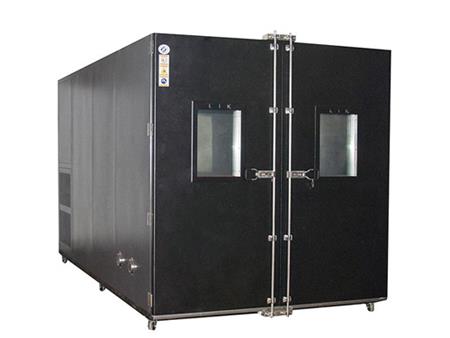
Walk-in high and low temperature test chamber

The walk-in high and low temperature alternating test chamber is used for the adaptability test of electrician, electronic product, and its original device, and other materials in storage, transportation and use under high temperature and low temperature environment. Used in the heat-resistant and cold-resistant tests of the defense industry, aerospace industry, auto parts, automotive parts, electronic components, plastics, chemicals, pharmaceuticals and related products, providing large-scale temperature and humidity testing environment for large parts, semi-finished products and finished products for the industry. Space, suitable for testing test equipment with large quantity and large volume.

1. The base of the test chamber is welded by 8# channel steel mesh structure, which has strong bearing capacity and can avoid the bottom bump and cracking phenomenon;
2, large double door and small slope design is convenient for large products and carts to enter and leave the test room, equipped with large window observation window and multiple sets of indoor LED explosion-proof lights to facilitate observation of product status;
3. The inner wall is made of 304 stainless steel, the outer box is made of high-quality color steel plate, the heat preservation medium is polyurethane rigid foaming, and has the characteristics of good light and heat insulation effect;
4. The positive pressure ceiling air circulation system is adopted, and the temperature uniformity and stability are high;
5. The door handle is open inside and outside, so that the tester can freely open the door from the closed room; the walk-in high and low temperature damp heat test room - controller features.

1, internal dimensions: customized according to customer requirements;
2. Temperature range: A: 0 °C ~ +150 °C; C: -20 °C ~ +150 °C; E: -40 °C ~ +150 °C; G: -60 °C ~ +150 °C; S: -70 °C ~ +150 ° C;
3, humidity range: 10% ~ 98% RH;
4. Temperature fluctuation: ±0.3 °C;
5, temperature uniformity: ≤ 2.0 ° C;
6, temperature deviation: ± 1.5 ° C;
7. Humidity fluctuation: ±3% RH;
8, box - box material - inner wall: SUS304 stainless steel plate;
9. Base plate: SUS304 stainless steel plate;
10. External: cold-rolled steel plate is sprayed; the surface is electrostatically sprayed after pickling and phosphating;
11. Insulation material: fireproof and resistant to burning, the thickness of the insulation material is 150 mm;
12. Insulation layer: the thickness of the inner insulation layer of the whole inner box is up to 150MM, and the refractory grade high strength PU polyurethane foam is used;
13, insulation insulation, materials (more heat-breaking than the general PU, fire-resistant effect);
14. Insulation coefficient: less than 0.012kcal/m·hr The insulation layer is fireproof with fireproof layer design, and the insulation layer is made of high temperature resistant rock wool plus fireproof gypsum board. It can ensure that the insulation material does not melt and burn after ignition in the test process in the box;
15. Control panel: imported PLC module (Japan Omron) + 10 inch color LCD touch control panel fault indicator, adjustable over temperature protection, total power switch, USB interface;
16, temperature and humidity sensor: armored platinum resistance PT100;
17, humidity sensor: Finland VAISALA0.8 humidity module sensor, humidity range 1-100% RH, temperature range: -100-200 ° C;
18. Display content: Check the direct input, display and control temperature, and cooperate with the special software of our company test box. The control system adopts man-machine dialogue mode; it has automatic, intelligent and humanized design; the control system can display and set test parameters. , program curve, working time, heater, refrigeration unit, fan working status. At the same time, it has automatic operation of test program and self-tuning function of PDI parameters; it can automatically combine subsystems such as heating system, refrigeration system, circulating fan and over-temperature alarm to ensure high control quality of the whole temperature control system, mainly implementing the SCHNEIDER brand of electrical appliances. Display accuracy: temperature 0.01 ° C, the analytical resolution of the control is: 0.001;
19. Software: Software V1.0. The curve and data recorded by the machine can be stored in the computer and networked. The stored data cannot be changed. The data can be retrieved at any time. The data can be viewed in any office. Computer software copyright registration certificate number: soft landing number No. 0698434;
20. Intake and exhaust device: The test box is equipped with a set of intake and exhaust devices. The panel operation switch can be used to manually control the exhaust operation, quickly introduce a large amount of air, and discharge the harmful gas in the test chamber out of the test chamber and through the exhaust duct. Connect outside the lab to avoid personal injury from harmful gases.

1. Meet GB/T 31485-2015 "Safety Requirements and Test Methods for Power Battery for Electric Vehicles" 6.1.2 Measurement instrument, meter accuracy and 6.3.10 temperature cycle requirements;
2. Meet GB/T 31486-2015 "Safety Requirements and Test Methods for Power Battery for Electric Vehicles" 6.1.2 Measurement instrument, meter accuracy and 6.3.10 temperature cycle requirements;
3, meet the requirements of GB/T 31467.3-2015 "Lithium-ion power battery packs and systems for electric vehicles - Part 3: Safety and test methods" 7.8 requirements for damp heat cycle;
4. Meet the requirements of QC/T 1023-2015 "General Requirements for Power Battery Systems for Electric Vehicles" 8.3.3 Constant Damp Heat;
5, meet the requirements of IEC 62660-2:2010 "Secondary batteries for the propulsion of electric road vehicles - Part 2 Reliability and abuse testing" 6.2.2.1.1 and 6.2.2.1.2 temperature cycle;
6. Meet the requirements of IEC 62660-3:2016 "Secondary batteries for the propulsion of electric road vehicles - Part 3 Safety requirements" 6.3.2.2 temperature cycle;
7. Meet ISO 12405-1:2011 "Electrically propelled road vehicles-Test specification for lithium-ion traction battery packs and systems-Part 1 High-power applications" 8.1 condensation-temperature change requirements;
8. Meet the requirements of ISO 12405-2:2012 "Electrically propelled road vehicles-Test specification for lithium-ion traction battery packs and systems-Part 2 High-energyapplications" 8.1 condensation-temperature change;
9. Meet QC/T 413-2002 "Basic technical conditions of automotive electrical equipment" 3.11 Requirements for temperature and humidity resistance change performance of products;
10. Meet ISO 16750-4:2010 "Environmental Conditions and Tests for Electrical and Electronic Equipment for Road Vehicles - Part 4: Climate Loads" 5.2 Temperature Gradient, 5.3 Temperature Cycle, 5.6 Damp Heat Cycle, 5.7 Steady-State Damp Heat Requirements;
11. Meet the IEC 60068-2-1:2007 low temperature test method Ab;
12. Meet the IEC 60068-2-2:2007 high temperature test method Bb;
13. Meet the IEC 60068-2-30:2005 alternating wet heat test method Db;
14. Meet the IEC 60068-2-78:2012 constant damp heat test method Cab;
15. Pass the GJB 150.3-86 high temperature test;
16. Pass the GJB 150.4-86 low temperature test;
17. Pass the GJB 150.9-86 damp heat test;
18. Pass the GJB 150.3A-2009 high temperature test;
19. Pass the GJB 150.4A-2009 low temperature test;
20. Meet the test requirements of the GJB 150.9A-2009 damp heat test;
21. Meet the acceptance test of GB/T 5170.2-2008 temperature test equipment;
22. Meet the acceptance criteria of GB/T 5170.5-2008 damp heat test equipment.


